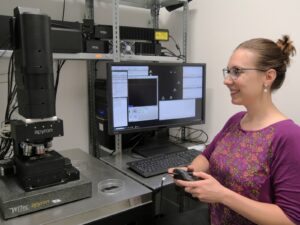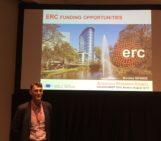
Hello Kara. Thank you for joining this edition of GeoTalk! Could you tell our readers a little bit about yourself and your background?
Thank you, Simon. I am excited to join you for the interview. I grew up in the middle of Germany in Bad Homburg, close to Frankfurt. After school, I travelled through Australia with occasional jobs, and after one year, I decided to return to Germany to study chemistry. However, after such an exciting year, I wanted to keep exploring new places and decided to study at the Technical University of Munich, which is close to the mountains and many lakes.
Although I moved around a little and wrote my Master’s thesis at Umicore (a company in Hanau, close to Frankfurt), I always returned to Munich, where I am currently doing my Ph.D. in Analytical Chemistry. In my opinion, it was valuable not only to focus on one direction but also to try different things. In my Master’s, I focused on Inorganic and Physical Chemistry, and now ended up in Analytical Chemistry with a very interdisciplinary topic. The environmental significance convinced me to change again and it still motivates me.
Your research is focused on testing whether plastic polymers are biodegradable. Can you explain how this works?
Compared to abiotic degradation, where a polymer is degraded due to exposure to UV radiation, mechanical stress, and others, biodegradation means that microorganisms are involved in the process. While I focus on bacteria, it could also be fungi.
Polymers consist of long chains of repeated monomeric subunits, like a necklace with many pearls. Since those chains are typically too big to be taken up by bacteria directly, they must first be broken down into smaller pieces. The bacteria first colonises the plastic surface, where they then excrete enzymes for the depolymerization of the polymer. The enzyme works like scissors to cut the necklace into small pieces so they are small enough to be taken up by the bacteria. They can be used either to produce energy, with water and CO2 as by-products, or to produce larger biomolecules for cell division and microbial growth.
To analyse whether this process has occurred, we label the polymer with stable isotopes and follow them as they transform into the final degradation products (water, CO2, or biomolecules). Heavier isotopes can be detected with spectroscopic methods, such as Raman spectroscopy; if we find a higher enrichment of heavier isotopes in the bacteria’s biomolecules (i.e. lipids, proteins, and DNA) we have proof that this single bacterial cell has taken up the label from the polymer by degrading it. Of course, the method requires controls and blanks, but that is the idea behind it – to monitor the uptake of stable isotope labels from a polymer into microbial biomass with Raman spectroscopy.
How could this help to reduce plastic pollution in the environment?
Most applications I can think of are connected to agricultural practices. There, plastics are commonly used (e.g., such as mulch films) but it’s impossible to retrieve the plastic entirely and it will end up in the environment. To counter this we need to analyse whether the plastic product is biodegradable in the soil under environmentally relevant conditions.
Since we want to improve the mechanistic understanding of the biodegradation process and the microbial uptake, this knowledge could be used to design new polymers with enhanced biodegradability. Furthermore, our method allows us to measure single bacterial cells.
If we can identify the bacterial species responsible for biodegradation, they could be added to the environment to speed up plastic degradation.
However, I am working on the analytical approach in my project, and all these applications are ideas for future projects.
You’re also experienced in communicating complex information to non-experts, such as producing a scientific brief for the International Atomic Energy Agency. How do you think scientists should approach communicating complex, and sometimes sensitive, topics like that of plastic pollution?
Typically, my approach is to use appealing images. If you don’t know who will listen to your presentation or read your brief, you can catch the audience’s attention by adding different layers of information to your graphics. For example, I like to show a bacterium that ‘eats’ a piece of plastic. The bacterium looks cute, and even people who know little about bacteria can engage. Then, I add details and note that the plastic is deuterated, telling the reader that I work with deuterium as the stable isotopes label.
It is good to simplify information for a broader audience, as long as you can justify it in front of experts.
My bacterium looks like it’s dancing in a spotlight to a random reader. Still, the expert will understand that the spotlight is the green laser beam and that I am measuring the vibrations of the biomolecules within the bacteria; images are not only valuable for catching attention, but also for providing scientific background. Seeing so many short courses about science communication at this year’s EGU assembly in Vienna was great.
The same rules apply to text: when I wrote the brief or the standard operating procedure for the International Atomic Energy Agency, I learned to explain what seemed obvious to me because simple words can be associated with different things depending on your background.
How plastic pollution is represented in the media landscape can be both alarming and subject to exacerbation. From your position as a researcher in plastic pollution, is there a key message – or myth you’d like to bust – about plastic pollution?
In all those publications and the flood of information on plastic pollution, it might not seem easy to decide whether the information is trustworthy. Most publications are about quantifying plastics in the environment or human organ; as an analytical chemist, I recommend constantly checking which controls have been performed and asking yourself whether there could be contamination from lab tools or the surroundings. This is the first step everybody can take.
It is always a good sign if there are positive and negative controls because making misinterpretations becomes less likely. For example, the presence of polystyrene was quantified using mass-based techniques based on monomer fragments. However, it was later discovered that these fragments can also appear in natural plastic-free samples, which should have been detected with plastic-free controls. To avoid this confusion, the fragment of the dimer (two monomeric subunits or, according to the previous simplification, two pearls of the necklace) is now used.





